The AMD Radeon RX 590 Review, feat. XFX & PowerColor: Polaris Returns (Again)
by Nate Oh on November 15, 2018 9:00 AM ESTCompute & Synthetics
Shifting gears, we'll look at the compute and synthetic aspects of the RX 580. As this is the 3rd time we're seeing 'big' Polaris, there's nothing new to discuss, and with no other design changes we only expect to see the impact of increased clockspeeds.
Beginning with CompuBench 2.0, the latest iteration of Kishonti's GPU compute benchmark suite offers a wide array of different practical compute workloads, and we’ve decided to focus on level set segmentation, optical flow modeling, and N-Body physics simulations.
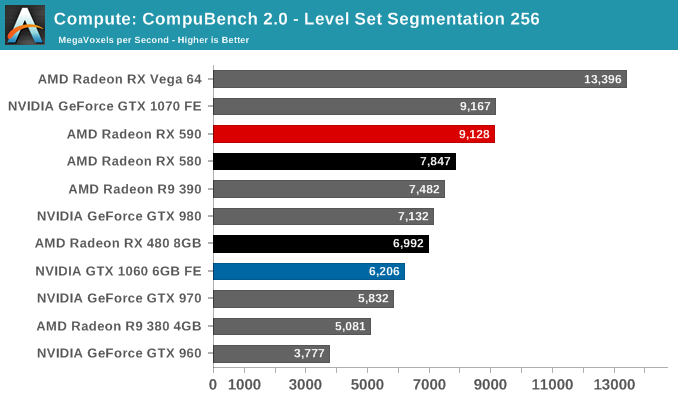

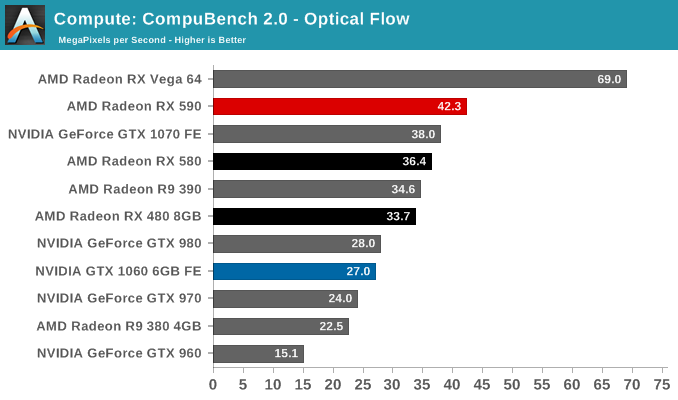
Moving on, we'll also look at single precision floating point performance with FAHBench, the official Folding @ Home benchmark. Folding @ Home is the popular Stanford-backed research and distributed computing initiative that has work distributed to millions of volunteer computers over the internet, each of which is responsible for a tiny slice of a protein folding simulation. FAHBench can test both single precision and double precision floating point performance, with single precision being the most useful metric for most consumer cards due to their low double precision performance.
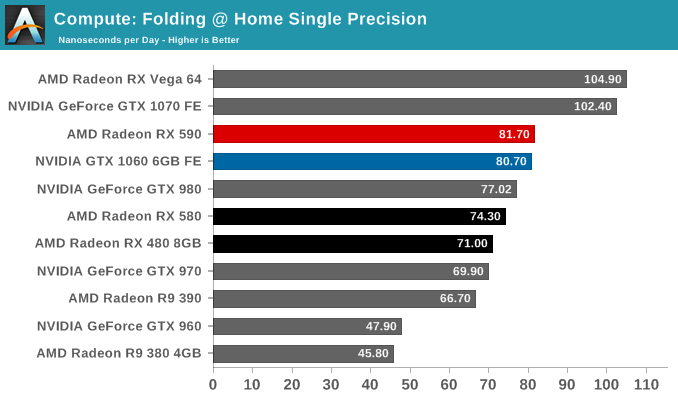
Next is Geekbench 4's GPU compute suite. A multi-faceted test suite, Geekbench 4 runs seven different GPU sub-tests, ranging from face detection to FFTs, and then averages out their scores via their geometric mean. As a result Geekbench 4 isn't testing any one workload, but rather is an average of many different basic workloads.
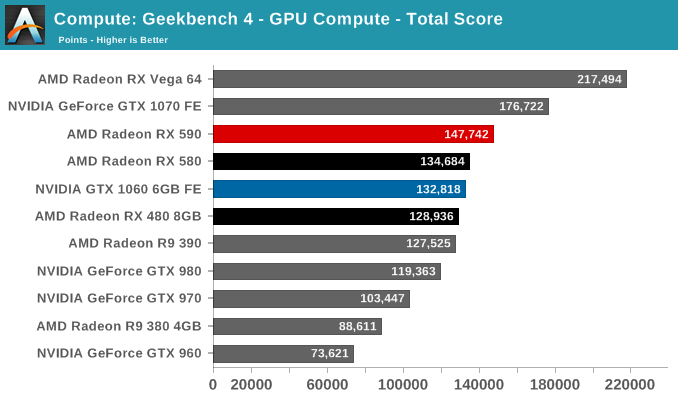
We'll also take a quick look at tessellation performance.

Finally, for looking at texel and pixel fillrate, we have the Beyond3D Test Suite. This test offers a slew of additional tests – many of which use behind the scenes or in our earlier architectural analysis – but for now we’ll stick to simple pixel and texel fillrates.
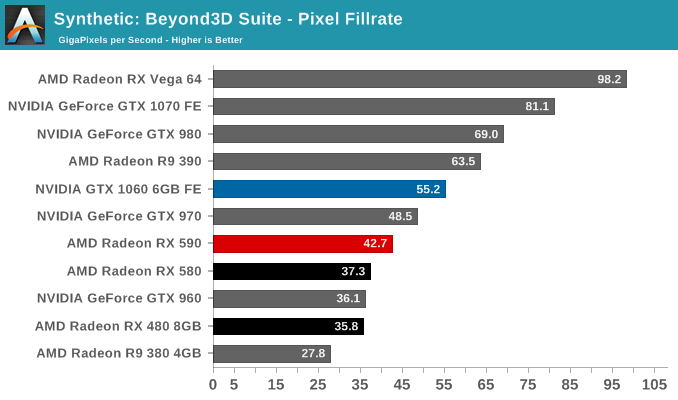











136 Comments
View All Comments
Kriswithak - Thursday, November 15, 2018 - link
I would love to see if the improved process offers better efficiency.With the RX480 4gb, I undervolted the card and saw a significant decrease in load power consumption.
With the RX580 8gb, I dropped the boost clocks a bit and dropped the voltage as well, and only used 6 pin power connector.
I would like to see the rx590/580/480 at similar reference/boost clocks, then undervolted to lowest possible stable and see what the frame per watt comparison is.
Nfarce - Thursday, November 15, 2018 - link
Just another example of AMD shooting their R&D wad at the APU/CPU segment and ignoring the GPU segment. There is ZERO reason to buy this fail over Nivdia unless you have already bought a Freesync monitor and a much older AMD GPU, which monitors, by the way, do work with Nvidia GPUs when locking down the v-sync tool. I have a Freesync 75Hz monitor ( 32" 1440p AOC) and love it with my GTX 1070 Ti locking in frames (bought it for $369 on NewEgg in a promo sale). Said 1070 Ti doesn't even need to breathe hard. Minimum FPS never comes close to hitting 75 FPS. Not only is it 30+% faster, but it also consumes nearly 20% less power under load than this card. Yeah, that's worth the extra $80 for my 1070 Ti in my book. You get what you pay for. I really hope AMD starts using some of their Ryzen revenue that they've been taking in for - nearly three years now mind you and not including their revenue stream from game console APUs - into upping their dedicated GPU game. Because they have a long way to go to match Nvidia in the upper tiers where the real price margin revenue is made. Nobody makes money on low and mid range GPUs where AMD has always targeted.eva02langley - Friday, November 16, 2018 - link
You are missing the point here, Lisa Su said that decision are took 3-5 years in advance for their roadmap.Polaris was already a thing and just making a 12 nm was an easy thing to do and was filling a gap.
People tend to forget that the 8GB RX 580 MSRP is actually 240$, not 200$ which is for the 4GB version. 30$ more is not such a step and still the cost per FPS is one of the lowest.
With a 100$+ of game bundle to add to it, there is no question that the value is there.
Flunk - Thursday, November 15, 2018 - link
Slightly overclocked RX 480 from two years ago? Wake me when AMD actually releases a new GPU.Cyborg997 - Thursday, November 15, 2018 - link
Can't believe this s*** with an AMD. 3 years with the same chips. What the f*** please give us something worth our money. Still have my Fury 9 runningAssimilator87 - Friday, November 16, 2018 - link
While everyone upped their resolution to UHD, I went the opposite direction and am running a CRT at 720p. My 7970's still running strong lol. CPU market is fire right now, but GPUs so boring =\piroroadkill - Friday, November 16, 2018 - link
So it sits somewhere between the 1060 6GB and 1070, most of the time closer to the former, and yet consumes a lot more power than either card. No thanks. People don't want noisy, hot systems these days without actually getting some performance to back it up.eva02langley - Friday, November 16, 2018 - link
It is actually quieter... check higher... seriously... people.Lolimaster - Friday, November 16, 2018 - link
It's really sad that 2 years after, performance per dollar went down.2 years more and we will have an APU with similar power than the RX580 on a $150 chip...
ItsAlive - Friday, November 16, 2018 - link
Now undervolt and overclock that gtx 1060, Mine was able to drop over 100mv, lowered power limit to 75%, but still overclocked 200/400 core/mem clocks and uses 75w max at full load. Temps typically run mid 60s with stock fan settings and its near silent. Its a mini card that is probably 1/3 the size of the RX590 and I bought it over a year ago for $250.If a stock gtx1060 uses typcially 120 watts max (mine would before the undervolt), then total system power for an undervolted card according to the charts in the article would look like this:
GTX1060/RX590/Fatboy
--------------------------------
BF1: 210w/363w/379w
Furmark: 206w/330w/362w
I would be interested to see an undervolted RX590 vs undervolted GTX1060 for a better comparison.